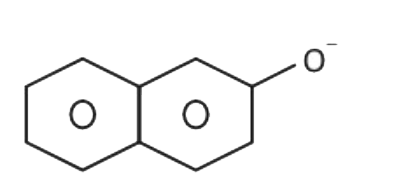Resonance structures can be written for .
O3
NH3
CH4
H2O
The correct Answer is:A
To determine which molecules can exhibit resonance structures, we need to follow a systematic approach. Here’s the step-by-step solution:
Step 1: Understand Resonance
Resonance occurs when a molecule can be represented by two or more valid Lewis structures. These structures differ only in the placement of electrons, not in the arrangement of atoms.
Hint: Look for molecules that have multiple bonds (double or triple bonds) and lone pairs of electrons.
Step 2: Identify the Criteria for Resonance
For a molecule to have resonance structures, it must:
- Have multiple bonds (double or triple bonds).
- Have lone pairs that can participate in bonding.
- Follow the octet rule for main group elements.
Hint: Remember that resonance structures must maintain the same arrangement of atoms.
Step 3: Analyze Examples
Let’s analyze a few examples:
1. Ozone (O3):
- Ozone has a structure with a double bond and a coordinate bond. It can be represented by two resonance structures where the double bond shifts between the two oxygen atoms.
- Resonance Structures: Yes, O3 has resonance structures.
2. Ammonia (NH3):
- Ammonia has a tetrahedral shape with no double or triple bonds. It has one lone pair but cannot shift bonds.
- Resonance Structures: No, NH3 does not have resonance structures.
3. Methane (CH4):
- Methane also has a tetrahedral geometry with only single bonds and no lone pairs.
- Resonance Structures: No, CH4 does not have resonance structures.
4. Water (H2O):
- Water has two lone pairs and single bonds, but it lacks multiple bonds.
- Resonance Structures: No, H2O does not have resonance structures.
Step 4: Conclusion
From the analysis, we conclude that only molecules with multiple bonds can exhibit resonance. Among the examples discussed, only ozone (O3) can be represented by resonance structures.
Final Answer: Resonance structures can be written for O3 (ozone).
Resonance occurs when a molecule can be represented by two or more valid Lewis structures. These structures differ only in the placement of electrons, not in the arrangement of atoms.
For a molecule to have resonance structures, it must:
- Have multiple bonds (double or triple bonds).
- Have lone pairs that can participate in bonding.
- Follow the octet rule for main group elements.
Let’s analyze a few examples:
- Ozone has a structure with a double bond and a coordinate bond. It can be represented by two resonance structures where the double bond shifts between the two oxygen atoms.
- Resonance Structures: Yes, O3 has resonance structures.
- Ammonia has a tetrahedral shape with no double or triple bonds. It has one lone pair but cannot shift bonds.
- Resonance Structures: No, NH3 does not have resonance structures.
- Methane also has a tetrahedral geometry with only single bonds and no lone pairs.
- Resonance Structures: No, CH4 does not have resonance structures.
- Water has two lone pairs and single bonds, but it lacks multiple bonds.
- Resonance Structures: No, H2O does not have resonance structures.
From the analysis, we conclude that only molecules with multiple bonds can exhibit resonance. Among the examples discussed, only ozone (O3) can be represented by resonance structures.
Topper's Solved these Questions
- CHEMICAL BONDING (BASIC)BOOK - VK JAISWAL ENGLISHCHAPTER - CHEMICAL BONDING (BASIC)EXERCISE - Level 2
62 Videos
- CHEMICAL BONDING (BASIC)BOOK - VK JAISWAL ENGLISHCHAPTER - CHEMICAL BONDING (BASIC)EXERCISE - Level 3 (Passive 1)
6 Videos
- CHEMICAL BONDING (ADVANCED)BOOK - VK JAISWAL ENGLISHCHAPTER - CHEMICAL BONDING (ADVANCED)EXERCISE - SUBJECTIVE PROBLEMS
64 Videos
- CO-ORDINATION COMPOUNDSBOOK - VK JAISWAL ENGLISHCHAPTER - CO-ORDINATION COMPOUNDSEXERCISE - LEVEL 2
144 Videos
Similar Questions
Knowledge Check
Which of the following is not a resonance structure of the other?
ACH3−N=C=SandCH3−S−C≡NBCH3−+C=OandCH3−C≡+OCCH3−O∣∣C−OHandCH3−O−∣C=+O−HDCH2=CH−C≡Nand+CH2−CH=C=N−
How many resonance structures are possible for allyl carbocation?
View SolutionIdentify the correct resonance structures of carbon dioxide from the one given below:
View SolutionIdentify the correct resonance structures of carbon dioxide from the one given below:
View SolutionHow many resonating structures are possible for the following structure (including the given structure)?

View SolutionWhich of the following is not a resonance structure of the other?
View SolutionWrite the resonance structures of the given compound.

View SolutionExplain the resonance structure of benzene. What do you understand by resonance hybrid?
View Solution
